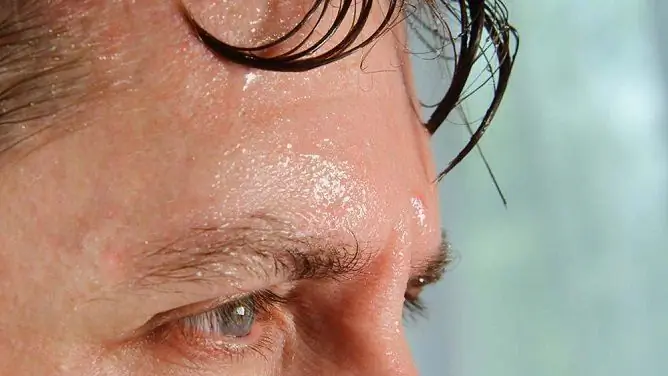- Author Rachel Wainwright [email protected].
- Public 2023-12-15 07:39.
- Last modified 2025-11-02 20:14.
What to do if a mole is inflamed
The content of the article:
- What is a mole
- Why moles get inflamed
- Symptoms
- Complications
- Diagnostics
- Treatment
- The consequences of self-medication
- Prevention
- Video
There are always moles on the body of any person (nevi, age spots). They are benign epidermal lesions and in most cases do not require surgical removal or any other treatment. But sometimes we are faced with the fact that the mole has become inflamed. Let's see if this condition is dangerous and what should be done to relieve inflammation.

An inflamed mole can be dangerous both in terms of possible malignancy and in relation to other complications.
What is a mole
The formation of age spots is associated with a significant accumulation of melanocytes - cells that produce the pigment melanin - in a small area of the skin. It is this pigment that gives color to the iris, hair and skin.
Normally, melanocytes are evenly distributed over the entire area of the skin. But sometimes, under the influence of some provoking factors, these cells can move and accumulate in large numbers on a small area of the skin, leading to the formation of a mole. These factors include:
- skin injuries;
- exposure to ultraviolet radiation;
- sharp fluctuations in hormonal levels;
- human papillomavirus (HPV) infection.
Why moles get inflamed
The causes of the inflammatory process in nevi can be:
- mechanical injuries (scratches, cuts, abrasions, bruises);
- burns (thermal, chemical):
- allergic reactions to insect bites, household chemicals, cosmetics;
- exposure to ultraviolet rays (sunbathing, visiting a solarium);
- frostbite;
- sharp changes in hormonal levels (pregnancy, menopause, hormonal therapy).
The inflammatory process can be caused either by the ingress of pathogenic microorganisms into the tissue of the neoplasm, or by its malignant transformation into melanoma. Therefore, if the mole becomes inflamed and reddened, it began to hurt, then it is imperative to consult a doctor - a dermatologist or oncologist.
Symptoms
Inflammation of a mole is easy to recognize based on the following clinical signs:
- the appearance around the neoplasm of a pale pink or red rim;
- swelling and redness extending beyond the mole;
- discoloration of the nevus;
- loss of the pigment spot of its clear contours;
- pain on palpation.
Often, itching and burning are the first signs of incipient inflammation.
Complications
If the infection from the nevus tissue spreads into the deeper layers of the skin, then this can lead to purulent inflammation of the sebaceous glands or hair follicles, that is, the formation of an abscess or a boil, respectively.
Diagnostics
If any changes have begun to occur with the mole, then you should go to the doctor as soon as possible, since they can be associated not only with infectious inflammation, but also with a life-threatening malignant transformation of the neoplasm.
Currently, the following diagnostic measures are carried out to identify possible malignancy:
| Diagnostic method | Description |
| Cytology | The slide is firmly pressed against the surface of the birthmark. The resulting print is then examined under a microscope. The detection of atypical cells is evidence of a malignant process. |
| Dermatoscopy | A modern method that allows you to diagnose melanoma at the earliest stage of development. The formation is examined using a fluorescent microscope, giving tenfold magnification. |
| Computer cropping | For this diagnostic method, it is necessary to make several high-quality images of the skin neoplasm with a high-resolution digital camera. The resulting photos are loaded into a computer and processed using a special program. |
| Histology |
It is used only with the complete removal of the inflamed mole by surgical excision or electrocoagulation. Allows you to make an accurate diagnosis in 100% of cases. |
Treatment
In cases where the cause of inflammation of the nevus is an infection, doctors prescribe conservative treatment, which includes:
- rubbing the skin around the mole with antiseptic solutions (ethyl alcohol, calendula tincture);
- application to the formation of salicylic or zinc ointment;
- the use of antibiotics and non-steroidal anti-inflammatory drugs (if indicated).
The indications for the removal of moles are:
- malignant transformation;
- pronounced cosmetic defect;
- location at which frequent trauma to the nevus occurs.
Currently, the following types of surgical treatment are performed:
- cryodestruction - destruction of education by deep freezing with liquid nitrogen;
- radio wave surgery - tissue destruction is carried out by exposure to high frequency radio waves;
- electrocoagulation - the tumor is burned out with a high-frequency electric current;
- laser destruction - a laser beam is directed at the tumor, which evaporates it layer by layer;
- surgical excision - rarely used, mainly for the removal of large formations in area and with suspicion of their malignant transformation.
The choice of the method of surgical treatment is carried out by the doctor, since each of them has its own indications and contraindications. But in most cases, doctors prefer laser destruction of the neoplasm, the advantages of which are:
- minimal damage to healthy tissue;
- almost complete absence of bleeding;
- low risk of wound infection, since laser radiation has a bactericidal effect;
- no scar or scar at the site of intervention.
That is why, for patients who have an inflamed mole on their face or neck, doctors recommend laser removal.

Suspicious or frequently inflamed moles should be removed
The consequences of self-medication
Many people believe that the inflammatory process of skin pigmentation is not a serious problem that requires a visit to a doctor, and they try to heal themselves. However, attempts at self-medication can lead to the spread of infection into deep-lying tissues with the formation of an abscess, boil, and phlegmon.
Prevention
To prevent possible inflammation of moles, you must:
- Wear comfortable clothing made from natural fabrics. Tight clothing with rough seams puts pressure on the nevus and injures it. The rubbed surface of the formation turns into an entrance gate for infection.
- Reduce skin exposure to ultraviolet rays. For this, you should refuse to visit the solarium, sunbathing. In the summer, before going outside during the daytime, sunscreen or lotion should be applied to exposed skin.
- Follow the rules of hygiene carefully. Sweat and dirt can cause the skin to itch a lot. This is accompanied by the appearance of scratches on it, through which pathogens penetrate.
- Be careful when shaving, epilating, playing sports. If there is a violation of the integrity of the skin, then the wound must be treated with an antiseptic solution (ethyl alcohol, tincture of iodine, alcohol solution of brilliant green).
In conclusion, I would like to emphasize once again that inflammation of a mole can develop under the influence of various factors and can pose a serious danger to human health. Therefore, you should not try to self-medicate, since in some cases the nevus must be urgently removed.
Video
We offer for viewing a video on the topic of the article.

Elena Minkina Doctor anesthesiologist-resuscitator About the author
Education: graduated from the Tashkent State Medical Institute, specializing in general medicine in 1991. Repeatedly passed refresher courses.
Work experience: anesthesiologist-resuscitator of the city maternity complex, resuscitator of the hemodialysis department.
Found a mistake in the text? Select it and press Ctrl + Enter.






